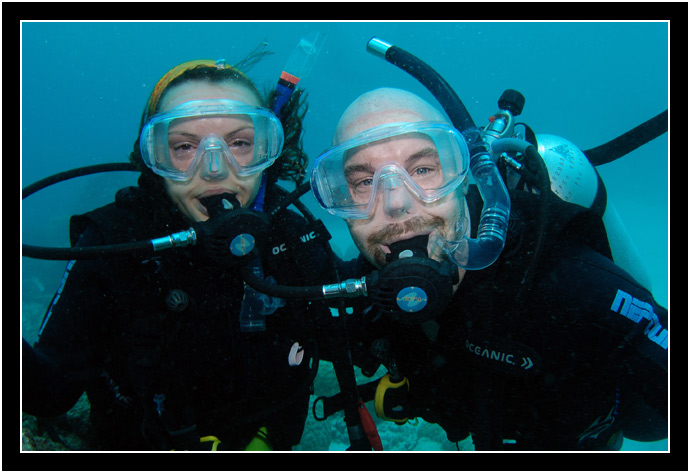
I’ve gone snorkeling hundreds of times, but it wasn’t until Oksana and I were in Australia that I finally got certified to dive. I’ve been surrounded by PADI certified diver-friends since at least high school; I don’t really know why it’s taken this long. Although money was always a consideration, I think I could have overcome that obstacle if I really wanted to. In retrospect, I think the reasons for putting off diving were four-fold:
- Not wanting to enroll in a course by myself
- The additional cost the hobby would incur (i.e., buying or renting gear)
- Thinking that snorkeling is essentially the same thing
- And, don’t tell anyone, but maybe just a little fear about submerging myself in an environment so hostile to human life
In the last couple of years, Oksana and I have toyed with the idea of getting certified in Juneau. We’ve had friends watching out for classes, reminding us when they start, vouching for different dive shops. For whatever reason, the stars never seemed to align, but when we bought our airline tickets to Australia, I realized that a huge opportunity – exploring the Great Barrier Reef – might be missed.
Oksana didn’t have time to attend a class in Juneau before we left, so I looked into what it would take to get us certified in Australia. I had reservations about spending so much of our precious vacation time in “school,” but I couldn’t fathom skipping the Great Barrier Reef, either. The prices on the websites I found were comparable to Juneau; about $350 was the minimum for a 3-day, Open Water certification class. We could swing the cost, could we swing the time?
We made it a priority.
Our original plan was to spend the first half of our vacation in Sydney and the Blue Mountains, and spend the second half in Cairns near the Great Barrier Reef. Hotel reservations in Sydney bollocksed things up, however, and we found ourselves booking airline tickets to Cairns sooner than expected. It never even occurred to us to check the weather beforehand. Should have. Cyclone Guba was spinning in place off Australia’s northeast coast.
Cairns was overcast when we got there, spitting rain sporadically throughout the day, but it was warm enough that it didn’t bother us as we walked around. We found what I hoped to be our best bet for dive schools, at least according to the web research I’d done earlier: Deep Sea Diver’s Den.
Oksana and I went in, picked up one of their brochures, and proceeded to spend half an hour battering the helpful girl behind the counter with questions. After much deliberation, it was Oksana who decided we should go all out. Two days of pool and classroom training, 4 days and 3 nights on the reef, a total of 15 open water dives, and an Advanced Open Water certification. Cost: about $1000 each. Worried that Guba might not even let us get wet, we hesitantly placed our credit card on the counter.
The next two days, Saturday and Sunday, were spent at the dive shop. Our class consisted of two Swedish guys, an Argentinean couple, and ourselves. We began with four hours in the classroom, watching videos and ever-so-quickly skimming through our textbooks. At the end of each chapter, we were rushed into a 10-question quiz. It took me awhile to realize that our instructor wasn’t at all concerned with our results. We only needed 7 of 10 correct on the quizzes, and, as a group, we self-checked our results, anyway. Still, I worried that the information was going by too quickly for me to absorb.
During the class, we also had our “medicals.” A doctor came to the dive shop and pulled each of us aside in turn. He checked our vitals, asked a few questions about our medical history, and tested our lung capacity. After blowing into a tube, an archaic computer screen analyzed the results for someone my height, weight, and age. The doctor said, “You’re at 108%, so, wow, yeah, no problems there.” Oksana passed, just barely, after scoring only 88%.
After lunch, we went right in the pool. TJ had us select a set of gear and then quickly went over how everything worked together. Too quickly, for my taste. Before I knew it, we were breathing under water in the shallow end.
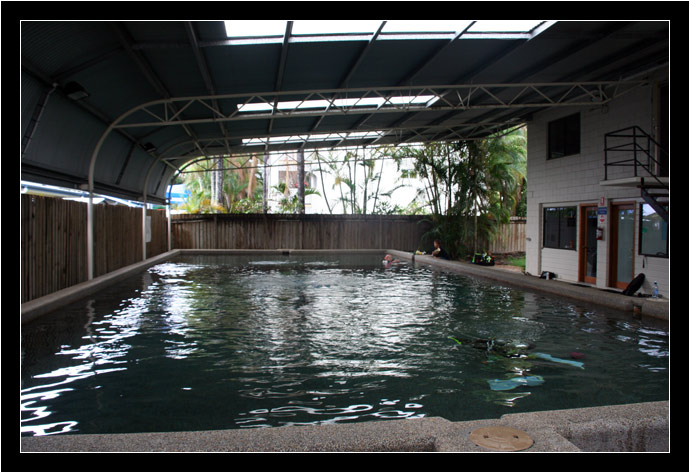
One of my biggest worries about learning how to dive was if I’d be able to clear my mask if and when it filled up with water. In snorkeling, it’s easy enough. You’re always near the surface, so if you can tread water for ten seconds, you can simply pull the mask away and let the water drain out. I figured the process might be different when you’re 20 meters down.
It was so easy. Pull the mask away from your lower face, leaving the top pressed against your forehead. Tip your head back. Exhale through your nose. Push the mask back against face. After my biggest fear was revealed to be such a non-issue, I stopped worrying and became much more receptive to the other lessons.
We learned the fin pivot, how to hover, and emergency assent procedures. We learned how to clear and completely remove our masks. We learned how to take off our equipment and put it back on, and how to assist a diver in distress.
The only thing that slowed me down was the lesson on “how to breath with a defective regulator.” We were supposed to simulate a failed regulator by holding down its purge valve (Regulators are built to fail in the ON position – they’ll never fail to supply you air while you still have some in your tank.) To breathe from a regulator that’s bubbling like crazy with expelled air, you need to tip your head on your side, put the mouthpiece half in your mouth, and let the air bubble up into your cheek. Our test, which we’d have to repeat if we didn’t pass, required us to breathe like that for at least 1 minute. I spent the first 20 seconds too scared to inhale because I could still feel water roiling around in my mouth. I was sure my first tentative sip of cold air would pull water into my lungs along with it and I would be coughing and sputtering my way to the top of the pool in no time. One tiny sip of air and I was okay. Another, slightly longer pull also worked. I spent the last 30 seconds marveling at the possibility that one can still breathe through their throat while water sloshes around in their mouth.
Oksana, for her part, had the most difficulty learning how to hover under water. Here’s how it works: First, you sink to the bottom of the pool. Then, slowly, you put a little bit of air into your BCD. At some point, you’ll have just enough air in your vest to counteract the weights on your belt and you’ll rise off the bottom. You have to be careful, however, because the air in your lungs affects your buoyancy. Take a deep breath, and you’ll rise like a balloon underwater. Rise high enough, the pressure of the surrounding water will drop… which will cause the air in your BCD and lungs expand further, and you’ll rise even faster. Pretty soon you’re on the surface, about as positively buoyant as you can get.
So what do you do? Time your breathing. Breathe in as you sink, breathe out as you rise. Get it right and you’ll hover in place, the up and down buoyancy of your breaths barely changing your position at all. Oksana’s problem with the exercise was TJ’s insistence on sitting in the lotus position. Oksana’s wetsuit resisted her efforts to bend her legs and she ended up fighting that instead of focusing on her breathing. Just like me and my regulator test, she figured it out before too long.
After our first full day of dive class, we decided to hit up a presentation in town called Reef Teach to learn a little more about what we might see on the Great Barrier Reef. Reef Teach was basically a PowerPoint presentation given by a couple our energetic, college-age girls. There was definitely an environmental/education slant, but the morals on display weren’t too overpowering. Besides, they had a lot of great underwater photographs of reef life, plus free coffee and cookies.
Our second day of training was much like the first, only reversed. Clouds spun off from Guba continued to pour rain on Cairns, but we didn’t mind; better to pass a rainy day in class, than a sunny one.
We started out in the pool, but this time without our gear. Part of the diving requirement is a demonstration of swimming strength. First, we had to swim 200 meters without touching the bottom of the pool. With no other limitation – no time limit, nor stroke requirements – it was simply a matter of counting out many, many laps. After that, we all had to tread water for 10 minutes. When someone asked if we could simply back-float instead, the entire class suddenly flipped up and stopped moving. It must have been quite the sight as the six of us gently drifted around the pool, occasionally bumping into each other.
The rest of our pool time was spent honing our underwater and equipment skills. More practice with the respirators, buoyancy control, maneuverability, and emergency situations. After 8 hours in the pool (over two days), I felt far more comfortable diving, but still a little leery about getting into the open ocean.
We broke for lunch and were back in the classroom for the rest of the afternoon. We rushed through a couple more quizzes and then took our final exam. It was open book, but I didn’t sweat it if I couldn’t find an answer. I was finally into the swing of things, not really worried if I missed a few questions. Actually, I missed four out of 50. Which still totally passes.
On the way back to our hotel room after class, I managed to do something really, really stupid. I dropped the bag that had our cameras (an SLR and a camcorder) in it. It only fell from a height of maybe one or two feet, but the shock was wholly absorbed by my 18-200mm lens. With great trepidation, I opened up the bag. Broken glass littered the bottom.
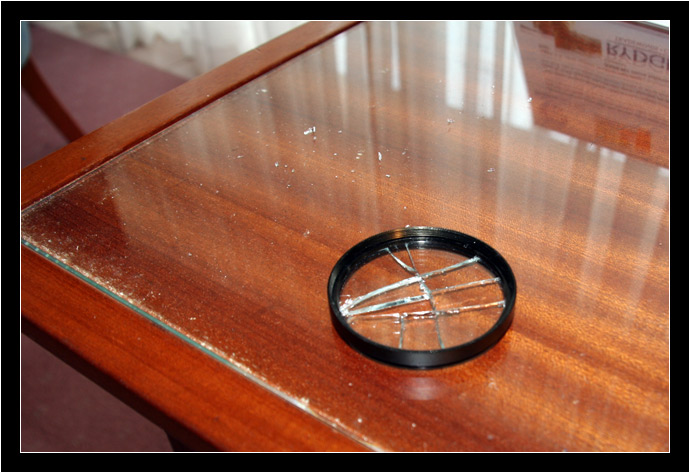
Back in the hotel room, I took a closer look. It appeared as though only the UV filter had broken. I gently unscrewed it, very carefully dusted the shards and powdered glass off the actual lens, and took a few test pictures. I couldn’t believe it, but it seemed like the fall didn’t knock anything else out of alignment. Still, I hate using a lens without a protective filter, and we were about to head out to the reef for four days. It was Sunday, and it was late, but we left immediately to see if we could find a photography store that was still open.
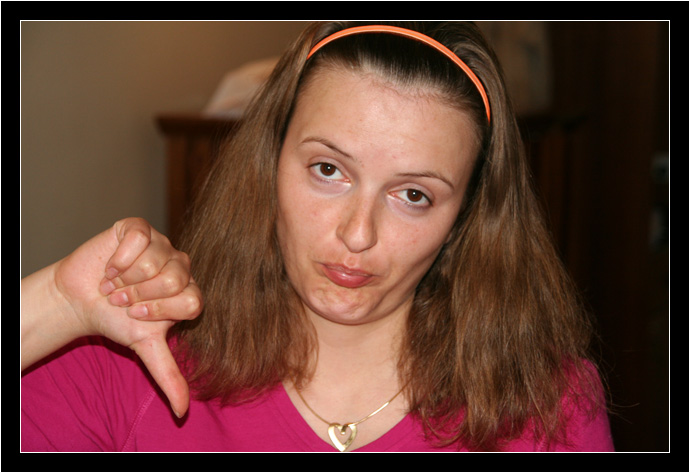
None were, or at least those that were still open didn’t have a 62mm UV filter. I considered leaving the SLR on land with the rest of our luggage, but eventually decided to just pack it and be very careful in the salt air. While we were out and about, though, we did pick up a bagful of munchies, a four-day supply of caffeine (Diet Coke), and some ginger pills and full-on Dramamine for the ride out to the reef – everyone was warning us that Guba was turning the water choppy.
The next morning, we gathered up our day bags and caught the Deep Sea Diver’s Den van down to the harbor. We loaded our stuff onto the Reef Quest, an 80ft catamaran, and were whisked out to the reef in about an hour-and-a-half’s time. Sure enough, the seas were white-capped, and almost a third of the passengers ended up on the back deck, forcefully packing their groceries into small paper bags.
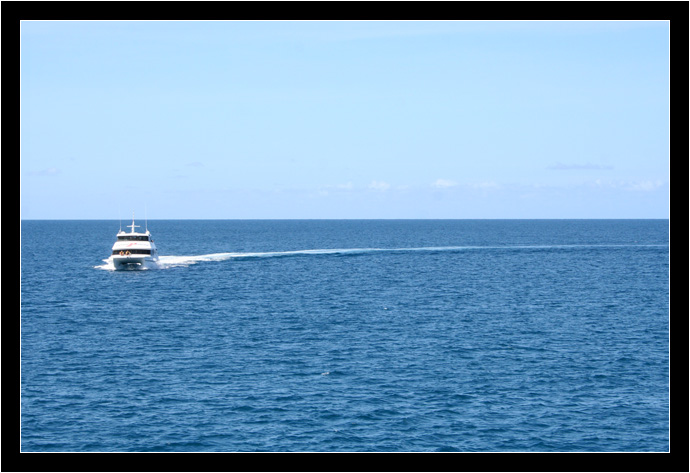
When we arrived on the reef, I was surprised. There was nothing to see from the boat! All around us, 360 degrees, nothing but water. I guess I sort of thought the mainland would be visible, or at least some islands, shoals… something! There were a few other boats disengorging tourists into the water, a large, semi-permanent floating platform, and a thin line of waves breaking over, presumably, the reef. Other than that, nothing but blue skies above and blue water below.
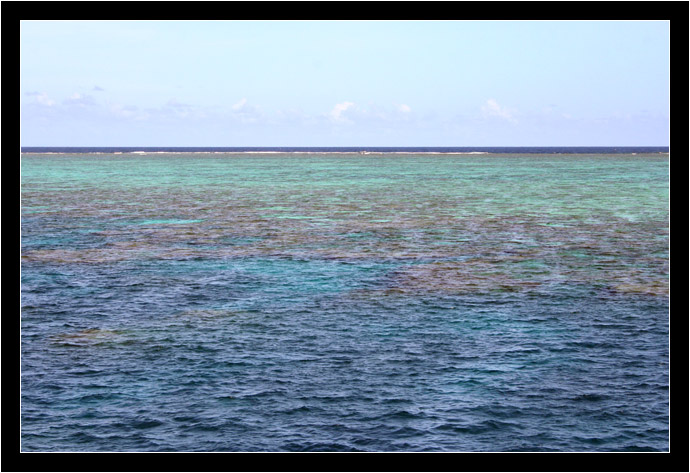
Actually, that’s not true. Cloudy, gray skies above, cloudy gray waters – whipped white on the surface – below. The deck of our boat rocked gently as we scrambled into our gear. TJ, our instructor from the shop, was still with us. He warned us that our first two dives would be rushed, but once we were on the overnight ship, things would settle down.
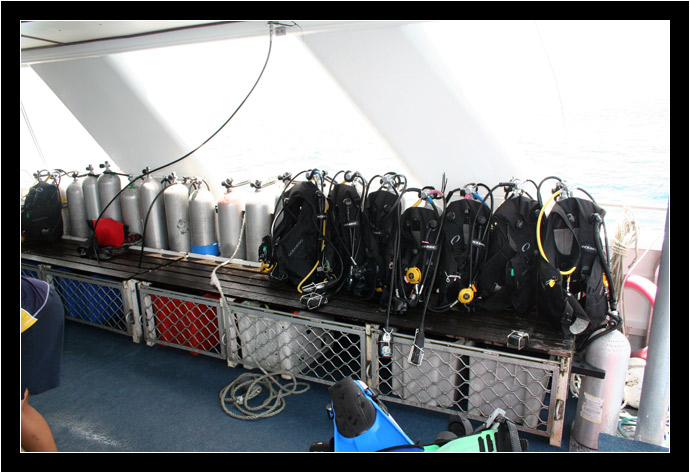
We geared up quickly, trying to remember the mnemonics we’d been taught. Begin With Review And Friend. Signal Orient Regulator Time Elevate Descend. TJ grouped us together on the crowded deck and gave us a quick briefing. The Swedes were still with us, as was the Argentinean couple. Two other divers who had done their pool work elsewhere joined in.
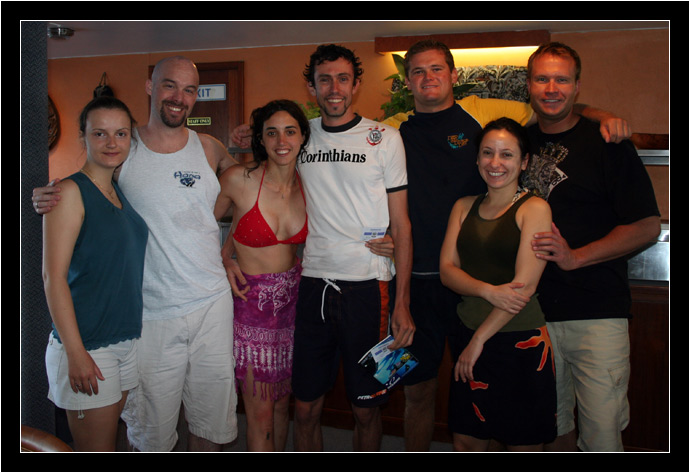
“Get in the water one at a time, group up on the descent line; we’ll go down as a group. I’ll lead you to a sandy spot on the bottom so we can continue practicing our dive skills. Same things we did in the pool: removing and replacing masks, the fin pivot, things like that. At some point, a photographer will come and pull you from the group for a photo op. If we have enough air left when we’re done, I’ll take you sightseeing along some of the coral. Once on the surface again, we will continue our skills check by removing weight belts and BCDs, then putting them back on. Any questions? No? Alright, let’s get in the water.”
I shuffled up to the side of the boat and fixed my mask into place. Left hand securing my weight belt and dive gages, the right pressing my mask and regulator to my face. I inhaled deeply, took a giant stride forward, stepped out into space. Here comes the Great Barrier Reef.

You must be logged in to post a comment.